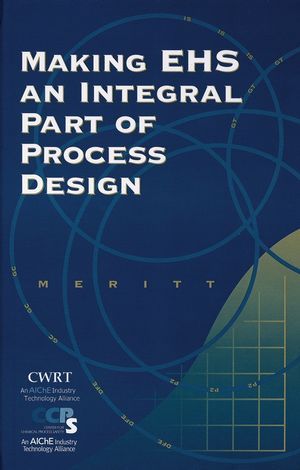Making EHS an Integral Part of Process DesignISBN: 978-0-8169-0848-6
Hardcover
164 pages
June 2001
 |
||||||
Acknowledgments.
Acronyms.
1. Introduction.
1.1 The Need for MERITT.
1.2 What Does MERITT Offer?
1.3 Whom Is MERITT for?
1.4 About the Book.
1.4.1 Scope.
1.4.2 Organization.
1.5 The Path Forward.
2. Value and Benefits.
2.1 The Value of MERITT.
2.1.1 Making More Efficient Use of Resources.
2.1.2 Examples of Success and Syneregy.
2.2 The Perils of Not Following the MERITT Approach.
2.3 The Business Case for MERITT.
2.3.1 Sustainability.
2.3.2 Meeting New Regulatory Demands.
2.4 The Need for Cost and Benefit Metrics to Demonstrate Value.
2.4.1 WBCSD.
2.4.2 ORC.
2.4.3 Recommendations Regarding Metrics.
3. Life-Cycle Stages.
3.1 Introduction.
3.2 Phases of Development.
3.3 Staging and Control.
3.3.1 Generic Stages.
3.3.2 Resource Allocation and Control.
3.3.3 Interpretation of Stages.
3.4 EHS Constraints and Opportunities.
3.4.1 Stage Constraints.
3.4.2 EHS Opportunities.
3.5 EHS Information Needs.
3.5.1 Requirements.
3.5.2 Anticipating Information Needs.
3.6 Fast-Track Development.
3.7 Plant Upgrades and Modifications.
3.7.1 Stage Iteration.
3.7.2 Creating MERITT Opportunity.
3.8 References.
4. The MERITT Opportunity.
4.1 The Foundation of MERITT.
4.2 MERITT Approach Overview.
4.2.1 The Basic MERITT Framework.
4.2.2 The Five “C” Fundamental Principles.
4.2.3 Resource Components.
4.2.4 Implementation Elements.
4.2.5 Overall Format—Fitting It All Together.
4.3 Application of MERITT to Stage-Gate Development Processes.
4.3.1 Early Stages-Concept Initiation (Stage 1) and Process Chemistry (Stage 2).
4.3.2 Process Definition (Stage 3).
4.3.3 Basic Process Engineering (Stage 4).
4.4 Fast Tracking with MERITT.
4.4.1 Fast Tracking Implementation Elements.
4.4.2 Fast Tracking Resource Components.
5. MERITT Tools.
5.1 Introduction.
5.1.1 Need for tools.
5.1.2 Purpose of Tools.
5.1.3 Types of Tools.
5.1.4 Relationship of Tools and Stages.
5.2 Available Tools.
5.2.1 Nonintegrated Tools.
5.2.2 Integrated Tools.
5.3 Need for Integrated Tools.
5.3.1 Role of MERITT Tools.
5.3.2 Illustrative MERITT Tools.
5.4 Development Needs.
5.5 Reference.
6. Application of MERITT.
6.1 Introduction.
6.2 Situation.
6.2.1 Waste.
6.2.2 Safety Hazards.
6.2.3 Green Chemistry Issues.
6.3 Nonintegrated EHS Approach.
6.3.1 Set Goals.
6.3.2 Define the Problem.
6.3.3 Identify Options.
6.3.4 Screening of Options.
6.3.5 Idea Evaluation.
6.3.6 Results.
6.4 MERITT Approach.
6.4.1 Establishing the Basis.
6.4.2 Identifying Issues.
6.4.3 Developing Options.
6.4.4 Assessing Options.
6.4.5 Improved Process.
6.4.6 MERITT Achievements.
6.5 Product Development Example.
6.5.1 Situation.
6.5.2 Use of MERITT.
6.6 References.
7. Implementation Guidance.
7.1 Incorporating MERITT into an Existing Process Development Process.
7.2 Integration with product Development Process.
7.3 Overcoming Behavioral and Cultural Barriers.
7.4 Metrics.
7.5 Addressing Industry-Specific Issues.
7.6 Applying to Small Companies.
7.7 Evaluating Licenses.
Appendix A. Additional Tools with Applicability to MERITT.
Appendix B. Overview of the INSET Tools and Their Aims.
Appendix C. The Business Case for Managing Process Safety.
Index.



